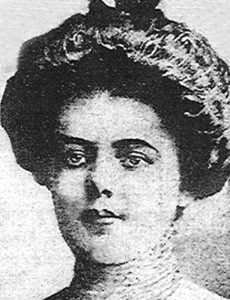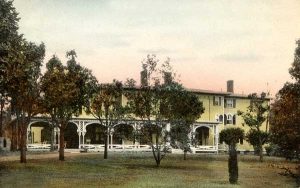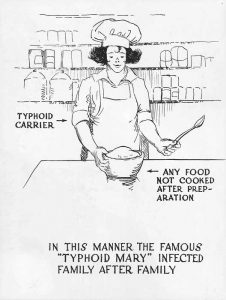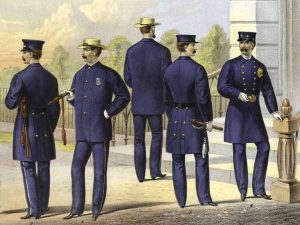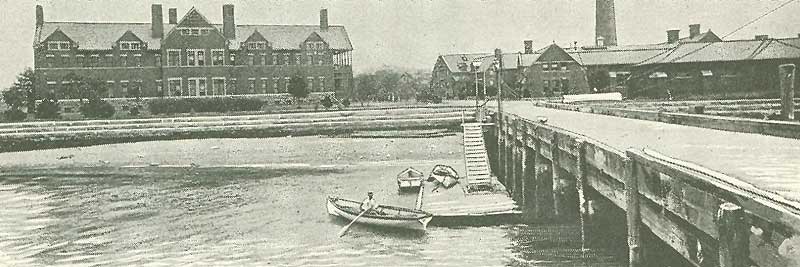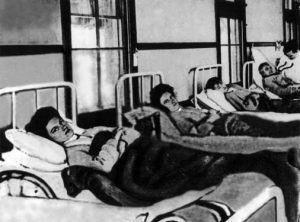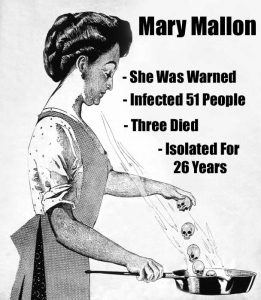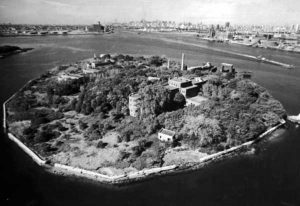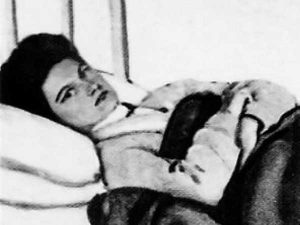By Joseph Bruno
She was an ignorant, ill-tempered woman but an excellent cook. However, Typhoid Mary Mallon’s refusal to accept that she was a healthy carrier of the deadly typhoid bacteria helped cause the deaths of at least three people.
Mary Mallon was born in 1869 in Cookstown, County Tyrone, Ireland. She emigrated to America in 1884 and worked in a succession of menial jobs until she discovered she had exceptional cooking talent. No one knows when the anomaly occurred, but sometime in the early 20th century, Mary became a healthy carrier of the typhoid bacterium (Salmonella typhi). Mary never got sick herself, so it was beyond her comprehension (or maybe she didn’t want to believe it was possible) that she was a monumental cause of extreme physical distress to other people who just happened to come into contact with her while she worked at her cooking profession.
Typhoid fever is a worldwide bacterial disease “transmitted by ingesting food or water contaminated with the feces of an infected person, containing the bacterium Salmonella enterica, serovar Typhi.” The bacteria then penetrates through the infected person’s intestinal walls into their bloodstream. The symptoms of an infected person include high fever, diarrhea, and gastroenteritis. If not treated properly, the fever can last up to four weeks and sometimes ends in the infected person experiencing delirium before finally dying. A person may become an asymptomatic carrier (suffering no symptoms) of the Typhoid bacteria, and 5% of the infected people continue to carry the disease after recovering.
The World Health Organization estimated that through the years 1906-1960, there were anywhere from 16-33 million cases of typhoid fever worldwide, with 216,000 resulting in fatalities. The age group with the highest incidence of infection is children and teenagers between the ages of five and 19 years old.
In the time period of around 430-424 BC, it is believed that typhoid fever killed one-third of the population of Athens, Greece, including Greek leader Pericles. During this period, the entire population of the peninsula of Attica was quarantined within the Long Walls and lived in tents.
Historians believe that in the English colony of Jamestown, Virginia, between 1607 and 1624, typhoid fever killed more than 6,000 settlers. During the Civil War, more than 81,000 soldiers died of either typhoid or dysentery. And in the 1890s, the typhoid fever mortality rate in Chicago, Illinois, averaged 65 per 100,000 people a year. The worst year was 1891 when the typhoid death rate was 174 per 100,000 people.
By all accounts, Mary Mallon worked steadily as a cook from 1900-1906. In the summer of 1906, Mary took a position as a cook for the family of New York banker Charles Henry Warren, who decided to take his family to a rented home in Oyster Bay, Long Island, New York, for their summer vacation. On August 24, one of Warren’s daughters got violently ill. She was subsequently diagnosed with typhoid fever. Soon, Warren’s wife took ill, as well as the gardener and another one of Warren’s daughters. Before the summer vacation was over, six of the eleven people living in the house were infected with typhoid bacteria.
George Thompson, who owned the home that Warren had rented, was worried he could no longer rent the house since he feared the water was contaminated and was the source of the typhoid bacteria. Thompson hired investigators to examine his water for other possible sources of contamination, but they were unsuccessful in discovering the source of the bacteria.
Thompson then hired George Soper, a civil engineer by trade, who had experience in typhoid fever epidemics. After eliminating one possible cause after another, Soper finally determined that it was the cook, Mary Mallon, three weeks gone from Warren’s employ, who had been the carrier of the disease. But Soper had no definitive proof, so he set out to find Mary and trace her employment history to see if there was a common denominator in Mary’s employment as a cook and typhoid outbreaks.
Through dogged grunt work and numerous knockings on people’s doors, Soper traced Mary’s employment record back to 1900. He was not too surprised to discover that from 1900-1907, Mary had worked at seven different households where 22 people had been infected with the typhoid bacteria, including one young girl who had perished from the disease.
It took Soper almost seven months, but in March of 1907, he was able to track down Mary, who was now working as a cook in the family home of Walter Bowen. Soper was intent on getting samples of Mary’s urine and blood, but the astounded, befuddled, and belligerent Mary would have none of that.
“I had my first talk with Mary in the kitchen of this house,” Soper said. “I was as diplomatic as possible, but I had to say I suspected her of making people sick and that I wanted specimens of her urine, feces, and blood. It did not take Mary long to react to this suggestion. She seized a carving fork and advanced in my direction. I passed rapidly down the long, narrow hall, through the tall iron gate, and so to the sidewalk. I felt rather lucky to escape.”
Still, Soper was determined and not deterred. The following day, he waited, hidden outside the Bowen residence, waiting for Mary to leave the house. When she did, Soper followed Mary (at a safe distance) to her home. Assured Mary was where she could easily be located, Soper left and soon returned with Dr. Bert Raymond Hoobler, who, as a doctor, might be able to convince Mary that testing her was the right thing to do. This tactic did not work well either, as Mary cursed at both men and chased them from her humble abode.
Knowing that Mary would not submit to any testing unless she was forced to do so, Soper went to the New York City Health Department and conferred with the department’s commissioner, Hermann Biggs. Commissioner Biggs agreed with Soper’s theories about Mary being a healthy carrier of typhoid bacteria. As a result, he decided to send a female doctor, Dr. S. Josephine Baker, to try to reason with Mary. However, this tactic didn’t work any better than the previous ones. Mary Mallon refused to be tested for the typhoid virus, and she made it very clear to Dr. Baker that she would not do so without a fight.
Dr. Baker soon returned to Mary’s residence, accompanied by five burly policemen and an ambulance. Dr. Baker described the scene: “Mary was on the lookout for us, and she peered out from the front door, a long kitchen fork in her hand like a rapier. As she lunged at me with the fork, I stepped back, recoiled onto the policeman, and was so confused that, by the time we got through the door, Mary had disappeared. ‘Disappear’ is too matter-of-fact a word; she had completely vanished.”
Baker and the police searched the house, but alas, no Mary Mallon was found. Finally, one of the policemen spotted a set of footprints in the corner yard that led from the house to a chair placed up against the fence separating Mary’s house from the house next door. The police then spent five hours searching both houses but to no avail. Finally, one of the policemen spotted “a tiny scrap of blue calico caught in the door of the areaway closet under the high outside stairway leading to the front door.”
The policemen forced open the door to the closet, and according to Dr. Baker, “She came out fighting and swearing, both of which she could do with appalling efficiency and vigor. I made another effort to talk to her sensibly and asked her again to let me have the specimens, but it was of no use. By then, she was convinced that the law only persecuted her when she had done nothing wrong. She knew she had never had typhoid fever; she was maniacal in her integrity. There was nothing I could do but take her with us. The policemen lifted her into the ambulance, and I literally sat on her all the way to the hospital; it was like being in a cage with an angry lion.”
Mary was taken to the Willard Parker Hospital in New York. Samples were taken and examined there, and surprisingly, typhoid bacilli was found in her stool. Without any trial or even a hearing of any sort, the Health Department transferred Mary to an isolated cottage, which was part of the Riverside Hospital, on North Brother Island in the East River near the Bronx.
Just like that, Mary Mallon went from being a fine cook to a pariah to a prisoner of the state. All without any due process from the courts. Yet, the New York City health officials said they could detain Mary Mallon indefinitely. The Health Department confirmed their decision by pointing to the powers vested in them from sections 1169 and 1170 of the Greater New York Charter, which said, ” The board of health shall use all reasonable means for ascertaining the existence and cause of disease or peril to life or health, and for averting the same, throughout the city. Said board may remove or cause to be removed to a proper place to be by it designated, any person sick with any contagious, pestilential or infectious disease; shall have exclusive charge and control of the hospitals for the treatment of such cases.”
The only problem was Mary Mallon was not sick with any symptoms of the typhoid virus, and it was not known at the time the statute was written that healthy carriers like Mary even existed. Therefore, the above statute should not have applied to her.
Mary pleaded with Riverside Hospital to release her case. “I never had typhoid in my life,” she said. “And I have always been healthy. Why should I be banished like a leper and compelled to live in solitary confinement with only a dog for a companion?”
In 1907, after Mary had been in confinement for two years, she finally sued the Health Department. Mary had sent her stool samples to a private lab for the previous year, and they all returned negative. However, when the Health Department tested Mary’s stools, 120 of 163 samples returned positive for the typhoid bacteria. So basically, there was a Mexican standoff regarding which lab tests were to be believed.
Before she had her day in court, Mary told the press, “This contention that I am a perpetual menace in spreading typhoid germs is not true. My own doctors say I have no typhoid germs. I am an innocent human being. I have committed no crime, and I am treated like an outcast — a criminal. It is unjust, outrageous, and uncivilized. It seems incredible that in a Christian community, a defenseless woman can be treated in this manner.”
Despite Mary’s pleas, the presiding judge in the case ruled in favor of the Health Department, and the person now called “Typhoid Mary” in the press “was remanded to the custody of the Board of Health of the City of New York.” Mary returned to her little isolated cottage on North Brother Island, where her faithful dog greeted her with glee. At this point, Mary was fearful she would spend the rest of her life in that cottage.
In February 1910, a new Health Commissioner was appointed in an astounding turn of events, and the new commissioner inexplicably ordered Mary to be released immediately. The only stipulation was that Mary had to sign an affidavit stating that she “is prepared to change her occupation (that of cook), and will give assurance by affidavit that she will upon her release take such hygienic precautions as will protect those with whom she comes in contact from infection.”
That being agreed to, Mary was set free after almost four years of confinement.
At this point in time, it would have been a happy ending for everyone if Mary had only stuck to the guidelines in her signed affidavit.
For a while, Mary did menial tasks, like those of a laundress, that did not pay as well as she was paid as a fine cook. It’s unclear exactly when, but sometime in 1914, Mary returned to working as a cook. And apparently, her hand-cleaning procedure did not measurably improve.
In January 1915, the Sloane Maternity Hospital in Manhattan suffered a typhoid fever outbreak. Twenty-five people became ill, and two of them died. Guess who was the newly hired cook for the facility? Why it was none other than “Typhoid Mary” Mallon herself, working under a fictitious name.
While public opinion was in her favor during Mary’s first detention, things were different this time. Whether she believed it or not, Mary was certified as a healthy carrier of typhoid bacteria. She knew that was the case, and she defied the Health Department, figuratively ripping up the affidavit she willingly signed. Mary returned to serving contaminated food, food she served to pregnant women. The fact that she used a fictitious name added more weight to Mary’s serious transgressions.
Mary Mallon was again shipped off to North Brother Island to the same cottage she had occupied before.
On her second and last visit to North Brother Island (which lasted 23 years until her death), Mary became a “hospital helper” but was not allowed to touch or even be near any food served to other people. Mary became a minor celebrity and was often interviewed by enterprising journalists, whom Mary was not even allowed to offer a glass of water.
In 1932, Mary suffered a severe stroke, which left her partially paralyzed and unable to work. At this point, she was transferred from her cottage to a bed in the hospital’s children’s ward.
Mary Mallon, more famously known as “Typhoid Mary,” died six years later on November 11, 1938. She was 69 years old.
An autopsy found evidence of live typhoid bacteria in Mary’s gallbladder.
In a classic case of overkill, the powers in charge at the hospital decided that Mary’s body, to destroy all traces of the typhoid bacteria, must be cremated immediately.
Mary Mallon’s ashes were buried at Saint Raymond’s Cemetery in the Bronx.
© Kathy Alexander/Legends of America, updated January 2024.
Also See:
Gangsters, Mobsters & Outlaws of the 20th Century
About the Author: A Vietnam veteran in the United States Navy, Joseph J. Bruno started in the newspaper business in the mid-1970s as a sports columnist for the New York Tribune. During the 1970s and ’80s, Bruno was an associate editor for Boxing Illustrated and a monthly contributor to Ring Magazine In 1986-1987, Bruno wrote a sports column for the Times Herald Record in Middletown, New York. Since then, he has written numerous articles for various magazines and several books — both fiction and non-fiction. More information can be seen on his blog here: John Bruno on the Mob. Source: Ezine Articles (dead link.)


